key AUDI A4 2013 Owner's Manual
[x] Cancel search | Manufacturer: AUDI, Model Year: 2013, Model line: A4, Model: AUDI A4 2013Pages: 302, PDF Size: 75.61 MB
Page 50 of 302

48 Clear vis ion
@ Tips
- The light sensor* for headlight control is
located in the rear view m irror mount.
You should therefore not apply any st ick
ers to the windsh ield in this area in order
to prevent malfunctions or failures.
- Some exterior lighting functions can be
adjusted
c> page 48.
- When you remove your key from the igni
tion while the vehicle's lights are turned
on, a buzzer sounds as long as the driv
er's door is open .
- In cool or damp weather, the ins ide of
the headlights, turn signals and tail lights can fog over due to the tempera
ture difference between the inside and
outside. They will clea r shor tly after
switching them on. This does not affect
the service life of the lighting.
- In the even t of a light sensor malfunc
tion, the driver is no tified in the instru
ment cluster disp lay ¢
page 22.
Turn signals and high beam lever
The lever operates the turn signals , the high
b eams and th e headlight flash er.
Fig . 4 1 Tu rn s ig na l an d h ig h beam leve r
Turn sign als ¢i ¢
The turn signals activate when you move the
l ever into a turn s ignal pos ition when the ign i
tion is switched on.
(D -right turn signal
@-left tur n signa l
The turn s ignal blinks three times if you just
tap the lever .
High be ams and headlight flasher [D
Move the lever to the correspon ding posit io n:
@ -high beams on
@ -high beams off o r headligh t fla sher
The indicator light
II in the i nstr ument clus
ter turns on .
Notes on thes e features
- The turn signals on ly work w ith the ign ition
t ur ned on. The indicator lights
B or II in
t he instrument cluster also blink.
- After you have turned a co rner, the tu rn s ig
na l switches off au toma tically .
- The
high beam works on ly w hen the head
lights a re o n. The indicator light
II in the
instrument cluster illuminates when the
high beams are on .
- The
headlight flasher works o nly as long as
you ho ld the lever -even if the re a re no
lights switched on . The ind icator light
II i n
the instrument cluster illum inates when you
use the headlight flasher.
A WARNING
--
Do not use the h igh beam or headlight
flashe r if you know that these could blind
oncom ing traffic.
Adjusting exterior lighting
The functions ore selected in the radio or
MMI" .
.,. Select: I CAR ! function button > Ext erio r
light ing .
Or
.,. Select: !CAR I function button > Car sys
tem s*
contro l button > Ve hicle settings >
Ext eri or lighting .
Coming home (light when leav ing car }* ,
L e aving home (light when unlocking car)*
The coming home function illuminates the
area around the vehicle when the ignition is
switched off and the dr ive r's door is opened .
Depend ing on vehicle equ ipment, the function
can be switched on and off or the length of
time the lights remain on* can be ad justed . ..,_
Page 52 of 302
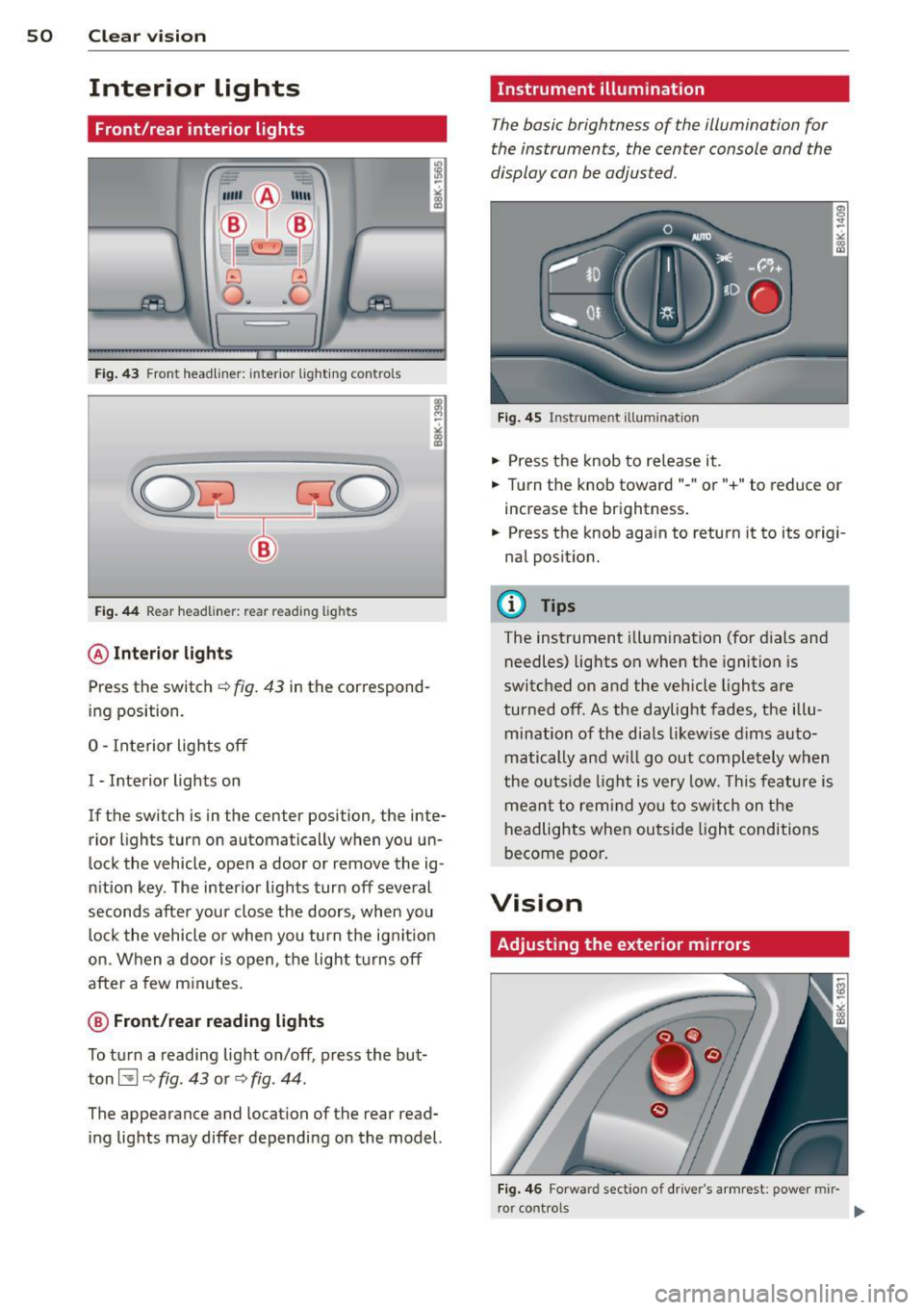
50 Clear vis ion
Interior lights
Front /rear interior lights
Fig . 43 Fro nt headliner : interior lig htin g con tro ls
Fig. 44 R ear headlin er: r ear rea ding lights
@ Interio r ligh ts
Press the switch ~ fig. 43 in the correspond
ing position.
0 -Interior lights off
I -Interior lights on
If the switch is in the cente r position, the inte
rior l ights turn on automatically when you un
lock the vehicle, open a door or remove the ig
n ition key . The interior lights turn off several
seconds after your close the doors , when you
lock the vehicle or when you turn the ign it ion
on. When a door is open, the light tu rns off
after a few m inutes.
@ Fr ont /rear r eading lights
To turn a reading light on/off , press the but
ton~
c::> fig . 43 or c::> fig . 44.
The appearance and location of the rear read
ing lights may differ depending on the model.
Instrument illumination
T he basic brightness of the illumination for
the instruments, the center console and the
display can be adjusted .
Fig . 45 Ins trum ent ill umin atio n
.,. Press the knob to re lease it .
.,. Turn the knob toward " -" or"+" to reduce or
increase the brightness .
.,. Press the knob aga in to return it to its origi
nal posit ion.
(!') Tips
The instrument illumination (for dials and
needles) lights on when the ignition is
switc hed on and the vehicle lights are
turned off . As the daylight fades, the illu
mination of the dia ls likewise dims auto
matically and wi ll go out completely when
the ou tside light is very low. This feature is
meant to rem ind yo u to sw itch on the
headlights when ou tside light conditions
become poo r.
Vision
Adjusting the exterior mirrors
Fig . 4 6 Forwar d sect io n of drive r's armr est: powe r mir
r o r contro ls
Page 53 of 302
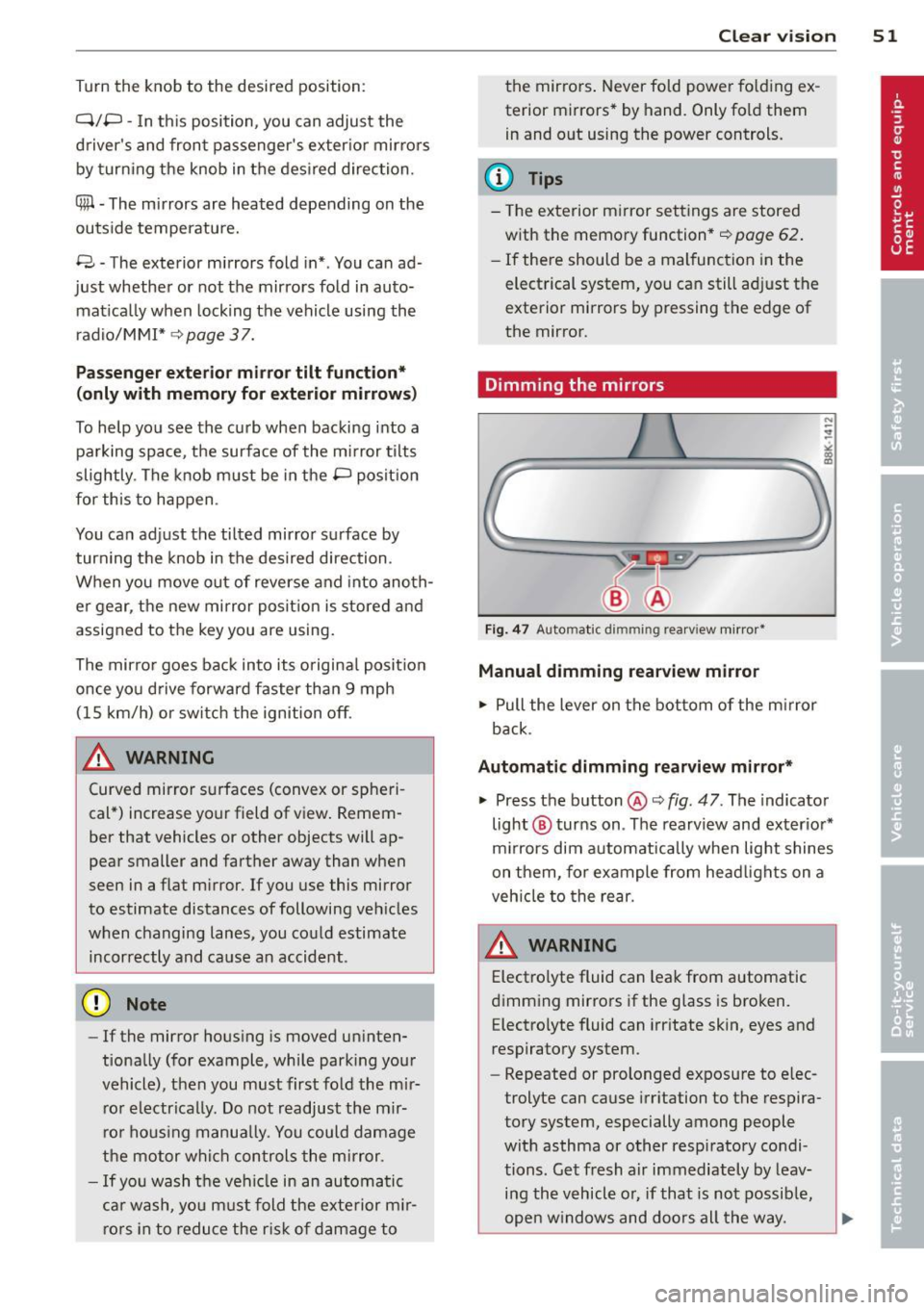
Turn the knob to the desired position:
Q/ P -In this position , you can adjust the
driver's and front passenger's exterior mirrors
by turning the knob in the desired direction.
(ijjl -The mirrors are heated depending on the
outside temperature.
8 -The exterior mirrors fold in*. You can ad
just whether or not the mirrors fold in auto
matically when locking the vehicle using the
radio/MM I*
c::> page 3 7.
Passenger exterior mirror tilt function*
(only with memory for exterior mirrows)
To help you see the curb when backing into a
parking space, the surface of the mirror tilts
slightly . The knob must be in the
P position
for this to happen .
You can adjust the tilted mirror surface by
turning the knob in the desired direction .
When you move out of reverse and into anoth
er gear, the new mirror position is stored and
assigned to the key you are using.
The mirror goes back into its original position
once you d rive forward faster than 9 mph
(15 km/h) or switch the ignition off .
,&. WARNING
Curved mirror surfaces (convex or spheri
cal*) increase your field of view. Remem
ber that vehicles or other objects will ap
pear smaller and farther away than when
seen in a flat mirror. If you use this mirror
to estimate distances of following vehicles
when changing lanes, you could estimate incorrectly and cause an accident.
(D Note
- If the mirror housing is moved uninten
tionally (for example, while parking your
vehicle), then you must first fold the mir ror electrically. Do not readjust the mir
ror housing manually. You could damage
the motor which controls the mirror .
-If you wash the vehicle in an automatic
car wash, you must fold the exterior mir
rors in to reduce the risk of damage to
-
Clear vision 51
the mirrors . Never fold power folding ex
terior mirrors* by hand. Only fold them
in and out using the power controls.
(D Tips
- The exterior mirror settings are stored
with the memory function*
c::> page 62.
- If there should be a malfunction in the
electrical system, you can still adjust the
exterior mirrors by pressing the edge of
the mirror.
Dimming the mirrors
N
:!
"' ~:::====~~=~====~ :ll
Fig. 47 Auto mat ic dimming re arv iew mirror*
Manual dimming rearview mirror
.. Pull the lever on the bottom of the mirror
back .
Automatic dimming rearview mirror*
.. Press the button @c::> fig. 47. The indicator
light @ turns on . The rearview and exterior*
mirrors dim automatically when light shines
on them, for example from headlights on a
vehicle to the rear.
A WARNING -
Electrolyte fluid can leak from automatic
dimming mirrors if the glass is broken. Electrolyte fluid can irritate skin, eyes and
respiratory system .
- Repeated or prolonged exposure to elec
trolyte can cause irritation to the respira
tory system, especially among people
with asthma or other respiratory condi
tions. Get fresh a ir immediately by leav
ing the vehicle or, if that is not possible,
open windows and doors all the way.
Page 55 of 302
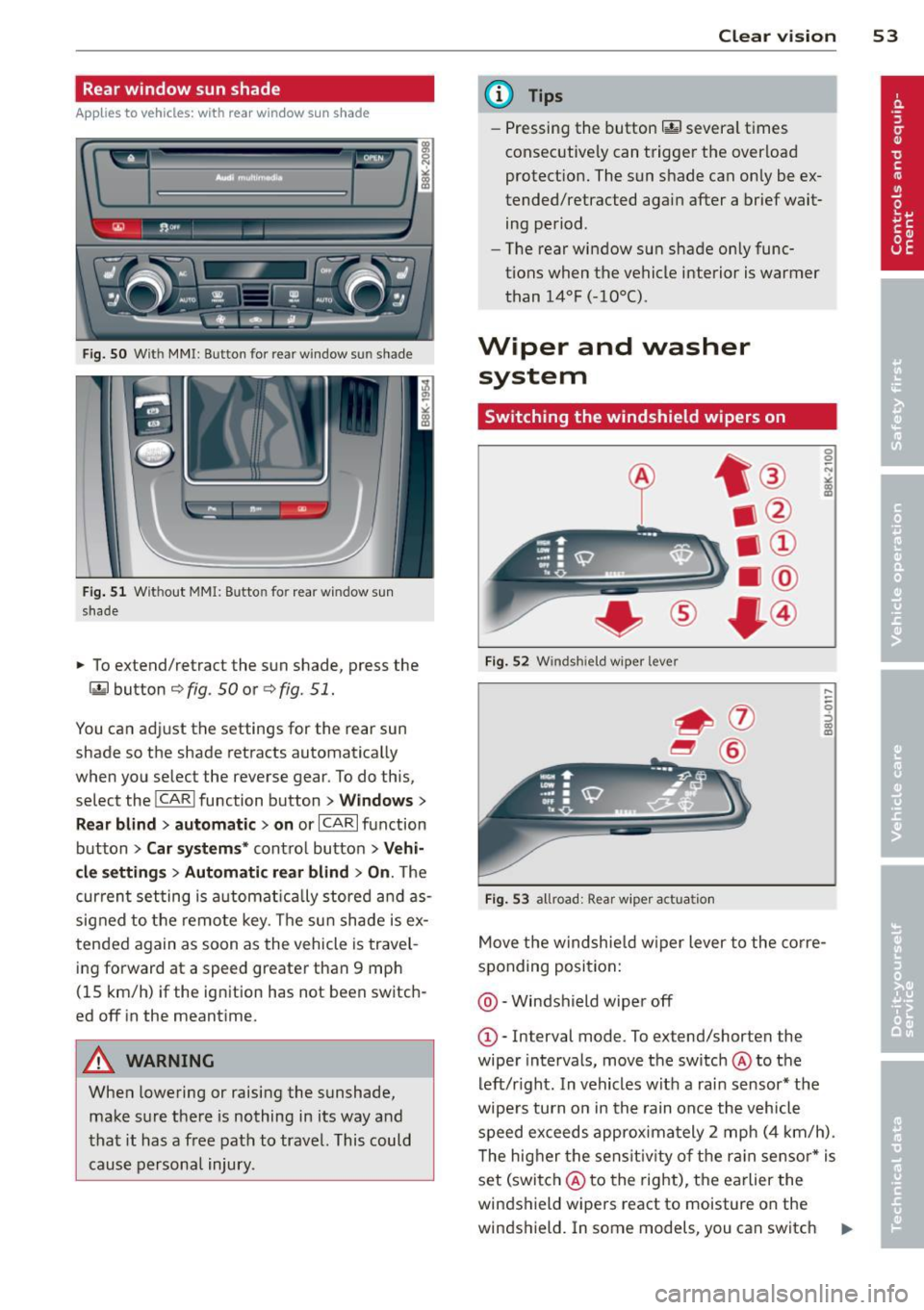
Rear window sun shade
Applies to vehicles: with rear window su n shade
Q;l I flc.i" , ~---
Fig. SO W it h MMI : Button for re ar window su n shade
Fig . 51 W it h out MMI: B utto n fo r rear wi ndow s un
s hade
• To extend/retract the sun shade, press the
laf.l button r=;> fig . 50 or ¢ fig. 51.
You can adj ust the settings for the rear sun
shade so the shade retracts automatica lly
when you select the reverse gear . To do this,
select the
! CARI function button> W indow s>
R ear blind > aut omati c> on
or ICARI function
button >
Car sy stem s* contro l button > V ehi
cl e s ett ings
> Autom atic re ar blind > On . The
cur rent setting is automat ica lly stored a nd as
signed to the remote key . T he sun shade is ex
tended again as soon as the vehicle is travel
ing forward at a speed greater than 9 mph
(15 km/h) if the ignit ion has not been switch
ed off in the meantime.
A WARNING
When lowering or raising the sunshade, make sure the re is nothing in its way and
that it has a free path to travel. This could
cause persona l injury .
-
Clear vi sion 5 3
@ Tips
-Pressing the button~ several t imes
consecutive ly can trigger the overload
protect ion. The sun shade can only be ex
tended/retracted aga in after a brief wait
ing period.
- The rear window sun shade only func
tions when the vehicle interior is warmer
than 14°F (-10°C) .
Wiper and washer
system
Switching the windshield wipers on
F ig . 5 2 Winds hie ld w iper leve r
Fig . 53 all road: Rear w iper ac tua tio n
0 0 N
"' :8
.....
-
-0 ::, a) m
Move the windshie ld w iper lever to the co rre
sponding posi tion:
@ -Windshield wiper off
G)-Interval mode . To ex tend/shorten the
wiper intervals, move the switch @to the
left/r ight. In vehicles w it h a rai n sensor* the
wipe rs turn on in the rain once the vehicle
speed ex ceeds approximately 2 mph (4 km/h) .
T he higher the sens it iv ity of the ra in sensor * is
set (switch @to the right), the earlier the
windshield wipers react to moisture on the
w indshield. In some models, you can switch
II-
Page 62 of 302
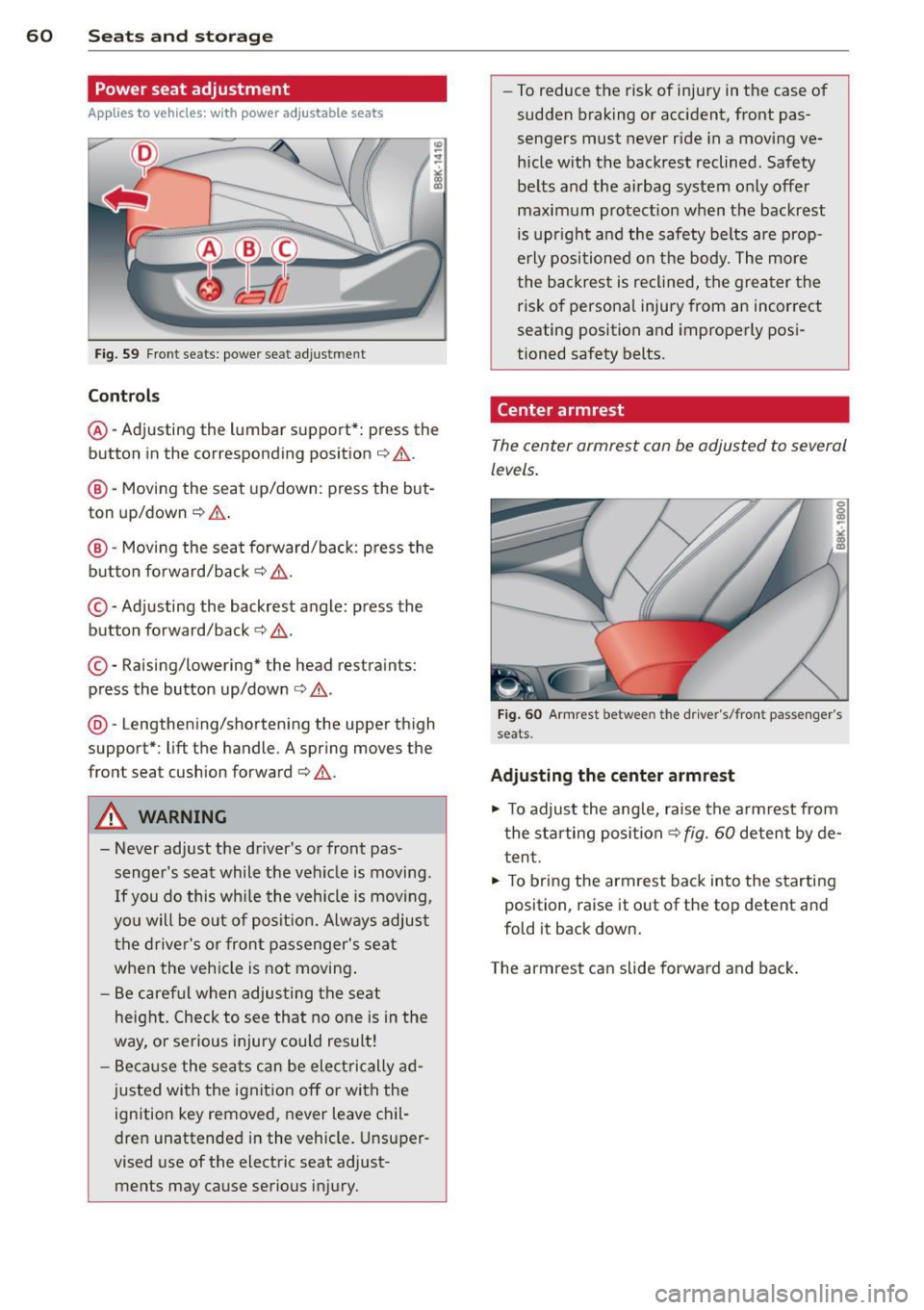
60 Seats and st o rage
Power seat adjustment
App lies to vehicles: with power adjustable seats
Fig. 59 Front seats: power seat adjustment
Controls
@ -Adj usting the lumbar support*: press the
button in the corresponding position¢.&..
@-Moving the seat up/down: press the but
ton up/down¢ .&..
@-Moving the seat forward/back: p ress the
button fo rward/back
¢ .&, .
©-Adjusting the backrest angle: press the
button fo rward/back
¢ .&. .
©-Raising/lowering* the head restraints:
press the button up/down ¢ .&. .
@ -Lengthening/shortening the upper thigh
support*: lift the handle. A spring moves the
front seat cushion forward¢.&..
A WARNING
- Never adjust the d river's or front pas
senger 's seat while the veh icle is moving.
If you do this wh ile the vehicle is moving,
yo u will be out of posit ion. Always adjus t
the drive r's or front passenger's seat
when the vehicle is not moving .
- Be care ful when adjus ting the seat
heig ht. Check to see that no one is in the
way, o r serious injury could result!
- B eca use the sea ts can be elec trically ad
justed with the ignit ion off or with the
ignition key removed, never leave chil
dren unattended in the vehicle. Unsuper
vised use of the electric seat adjust ments may cause serious injury. -
To reduce the risk of injury in the case of
sudden braking or accident, front pas
sengers must never r ide in a moving ve
hicle with the backrest reclined. Safety
be lts and the airbag system only offer
maximum protection when the backrest is upr ight and the safety belts are prop
e rly po sitioned on the body. The more
the backres t is reclined, the grea ter the
risk of persona l injury from an incorrect
seating position and imprope rly posi
tioned safety belts.
Center armrest
The center armrest can be adjusted to several
levels .
Fig. 60 A rm rest between the driver's/front passenger's
seats.
Ad ju sting the center armrest
"" To adjust the ang le, raise the arm rest from
the starting position
¢ fig. 60 detent by de
t en t.
.,. To bring the armres t back into the starting
position, raise it out of the top detent and
fold it back down.
T he armrest can slide forwar d and back .
Page 63 of 302
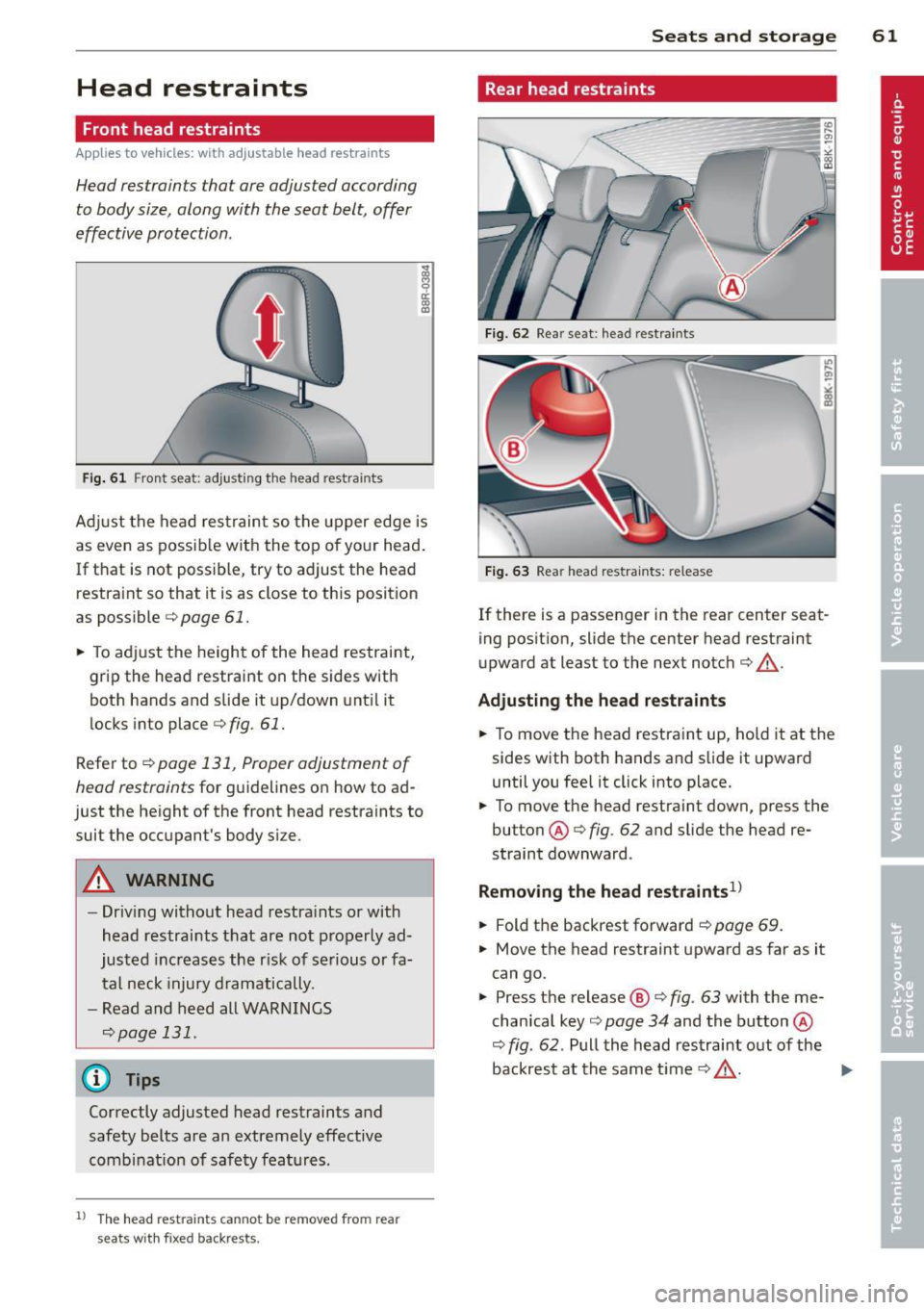
Head restraints
Front head restraints
Applies to vehicles: with adj ustable head restraints
Head restraints that ore adjusted according
to body size, along with the seat belt , offer
effective protection .
Fig. 61 Fron t seat: adjusting the head rest ra in ts
Ad just the head restraint so the upper edge is
as even as possible with the top of your head.
If that is not poss ible, try to adjust the head
restraint so that it is as close to this position
as possible
c> page 61.
~ To adjust the height of the head restraint,
grip the head restraint on the sides with
both hands and slide it up/down until it
locks into place
c>fig. 61.
Refer to¢ page 131, Proper adjustment of
head restraints
for guidelines on how to ad
just the height of the front head restraints to
suit the occupant's body size .
A WARNING
-Driving without head restra ints or with
head restraints that are not properly ad
justed increases the r isk of serious or fa
tal neck injury dramatically.
- Read and heed all WARNINGS
c>page 131.
@ Tips
Correctly adjusted head restraints and
safety belts are an extremely effective
combinat ion of safety features .
l) The head restra ints cann ot be re move d fro m rear
se ats with fixe d backr ests.
-
Seats and storage 61
Rear head restraints
Fig. 62 Rear seat : head restraints
Fig. 63 Rear head restraints: release
If there is a passenger in the rear center seat
ing position, slide the center head restraint
upward at least to the next notch¢&_.
Adjusting the head restraints
~ To move the head restraint up, hold it at the
sides with both hands and slide it upward
until you feel it click into place.
~ To move the head restraint down, press the
button @¢
fig. 62 and slide the head re
straint downward .
Removing the head restraints1>
~ Fold the backrest forward¢ page 69.
~ Move the head restraint upward as far as it
can go.
~ Press the release@¢ fig. 63 with the me
chanical key¢
page 34 and the button @
¢
fig . 62 . Pull the head restraint out of the
backrest at the same time¢&_ .
~
Page 64 of 302
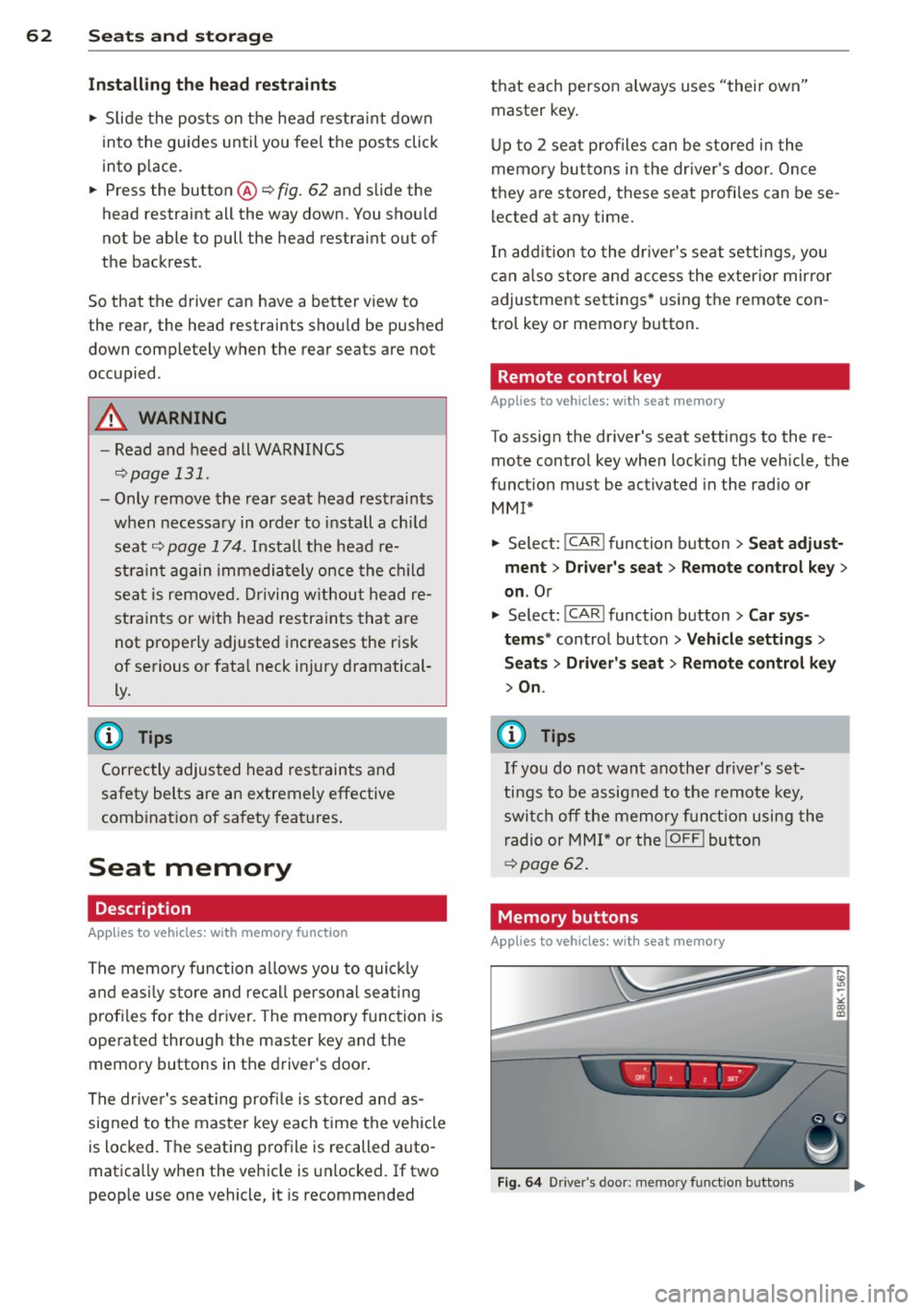
62 Seats and storage
Installing the head restraints
.. Slide the posts on the head restra int down
into the guides until you feel the posts click
into place.
.. Press the button @
Q fig. 62 and slide the
head restraint all the way down. You should
not be able to pull the head restraint out of
the backrest .
So that the driver can have a better view to
the rear, the head restraints should be pushed
down completely when the rear seats are not
occupied.
A WARNING
- Read and heed all WARNINGS
~page 131.
-Only remove the rear seat head restraints
when necessary in order to install a child
seat ~
page 174. Install the head re
straint again immediately once the child
seat is removed. Driving without head re
straints or with head restra ints that are
not properly adjusted increases the risk
of serious or fata l neck injury dramatical
ly.
@ Tips
Correctly adjusted head restraints and
safety belts are an extremely effective
comb inat ion of safety features .
Seat memory
Description
Applies to vehicles: with memory function
The memo ry function allows you to quickly
and easily sto re an d recall personal seating
profiles for the driver. The memory function is
operated through the master key and the memory buttons in the driver's door.
The drive r's sea ting profi le is stored and as
signed to the master key each time the vehicle
is locked. The seating profile is recalled auto
matica lly when the vehicle is unlocked. If two
peop le use one vehicle, it is recommended that each person always uses "their own"
master key .
Up to 2 seat profil es can be stored in the
memory buttons in the driver's door. Once
they are stored, these seat profiles can be se
lected at any time.
In addition to the driver's seat settings, you
can also store and access the exterior mirror
adjustment settings* using the remote con
tro l key or memory button.
Remote control key
Applies to vehicles: with seat memory
To assign the dr iver 's seat settings to the re
mote control key when locking the veh icle, the
funct ion must be act ivated in the rad io or
MMI*
.. Select: I CAR I function button > Seat adjust
ment
> Driver's seat > Remote control key >
on.Or
.. Select:
!CAR ! function button> Car sys
tems *
control button > Vehicle settings >
Seats > Driver 's seat > Remote control key
> On.
@ Tips
If you do not want another driver's set
tings to be assigned to the remote key,
switch off the memory function using the
radio or
MMI* or the !OFFI button
~page 62.
· Memory buttons
Appl ies to vehicles: wit h seat memory
Fig. 64 Driver's door: memory function buttons
Page 67 of 302
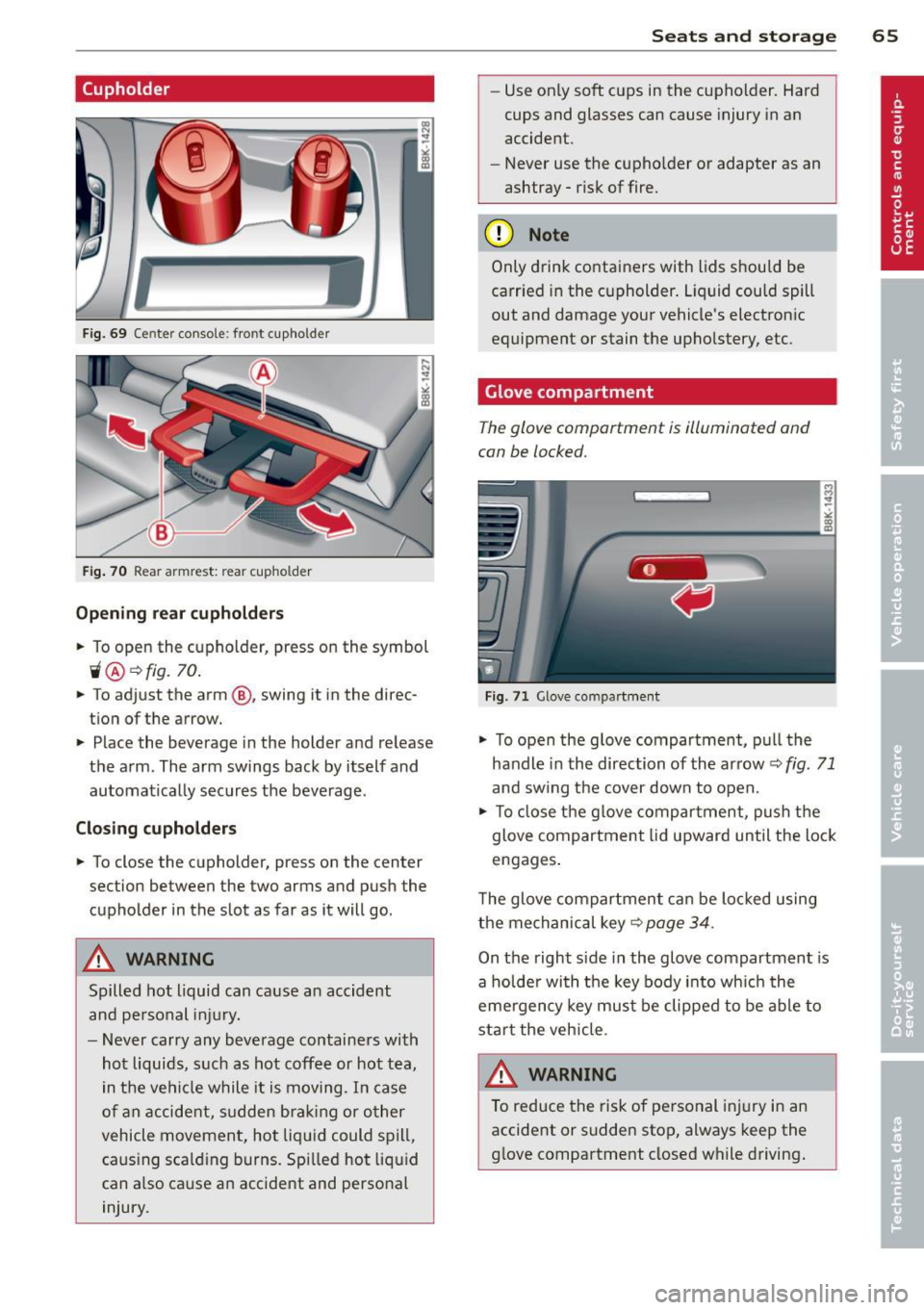
(upholder
Fig. 69 Ce nter console: front cupholder
Fig. 70 Rear armrest: rea r cupho lder
Opening rear cupholders
~ To open the cupholder, press on the symbol
ii@ ~ fig. 70 .
~ To adjust the arm @, swing it in the direc
tion of the arrow.
~ Place the beverage in the holder and release
the arm. The arm swings back by itself and
automatically secures the beverage .
Closing cupholders
~ To close the cupholder, press on the center
section between the two arms and push the
cupholder in the slot as far as it will go.
A WARNING
Spilled hot liquid can cause an accident
and personal injury.
- Never carry any beverage containers with
hot liquids, such as hot coffee or hot tea,
in the vehicle while it is moving . In case
of an accident, sudden braking or other
vehicle movement, hot liquid could spill,
caus ing scald ing burns . Spilled hot liquid
can also ca use an accident and personal
injury.
Seats and storage 65
-Use on ly soft cups in the cupholder. Hard
cups and glasses can cause injury in an
accident.
- Never use the cupho lder or adapter as an
ashtray -risk of fire.
(D Note
Only drink containers with lids should be
carried in the c upholder. Liquid could spill
out and damage your vehicle's electronic
equipment or stain the upholstery, etc.
Glove compartment
The glove compartment is illuminated and
can be locked.
Fig . 71 G love compar tment
~ To open the glove compartment, pull the
handle in the direction of the arrow~
fig. 71
and swing the cover down to open.
~ To close the glove compartment, push the
glove compartment lid upward until the lock
engages .
T he glove compartment can be locked using
the mechanical key~
page 34.
On the right side in the glove compartment is
a holder with the key body into which the
eme rgency key must be clipped to be able to
start the veh icle.
&_ WARNING
To reduce the risk of personal injury in an
accident or sudden stop, always keep the
glove compartment closed while driving.
-
Page 71 of 302
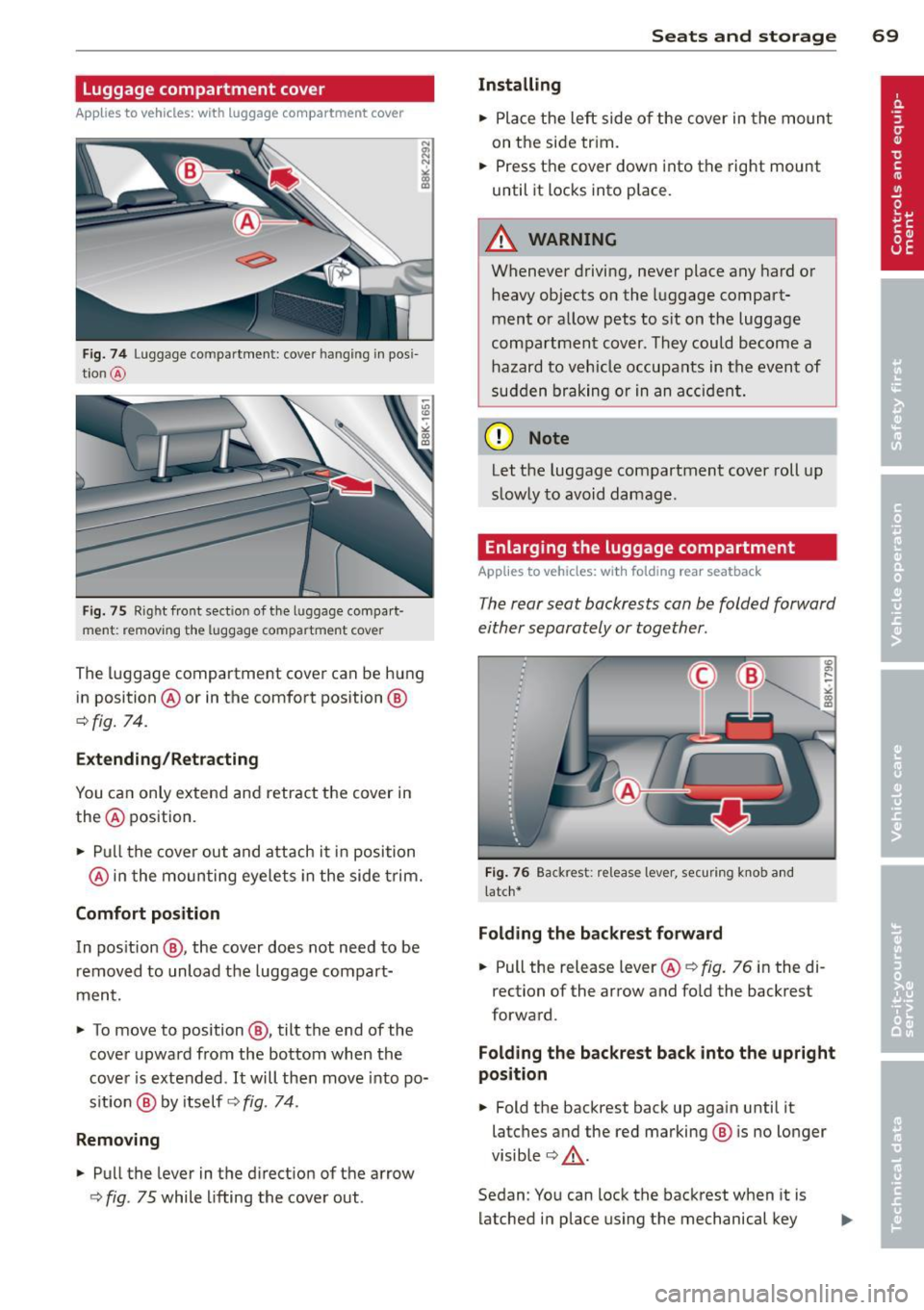
Luggage compartment cover
Applies to vehicles: with luggage compartment cover
Fig. 74 Luggage compartment: cover hangi ng in pos i
t ion @
Fig. 75 Rig ht front section of the l uggage compart
ment : removing the luggag e compartment cove r
The luggage compartment cover can be hung
in position @or in the comfort position @
¢fig. 74.
Extending /Retracting
You can only extend and retract the cover in
the @ position .
• Pull the cover out and attach it in position
@ in the moun ting eyelets in the side trim.
Comfort position
In pos ition @, the cover does not need to be
removed to unload the luggage compart·
ment.
• To move to position @, tilt the end of the
cover upward from the bottom when the
cover is extended . It will then move into po·
s ition @ by itself
c::;, fig . 7 4.
Removing
• Pull the lever in the direction of the arrow
c::;, fig . 75 while lifting the cover out .
Seats and storage 69
Installing
• Place the left side of the cover in the mount
on the side trim.
• Press the cover down into the right mount
until it locks into place.
A WARNING
=
Whenever driving, never place any hard or
heavy objects on the luggage compart·
mentor allow pets to s it on the luggage
compartment cover . They could become a
hazard to vehicle occupants in the event of
sudden braking or in an accident.
ffi Note
Let the luggage compartment cover roll up
slow ly to avoid damage.
Enlarging the luggage compartment
Applies to vehicles: wit h fo lding rear seatback
The rear seat backrests can be folded forward
either separately or together .
Fig. 76 Backrest: release lever, securing knob and
latch*
Folding the backrest forward
• Pull the release lever@¢
fig. 76 in the di
rection of the arrow and fold the backrest
forward.
Folding the backrest back into the upright
position
• Fold the backrest back up again until it
latches and the red marking @ is no longer
visible
c::;, _&. .
Sedan : You can lock the backrest when it is
latched in place using the mechanical key
Page 76 of 302
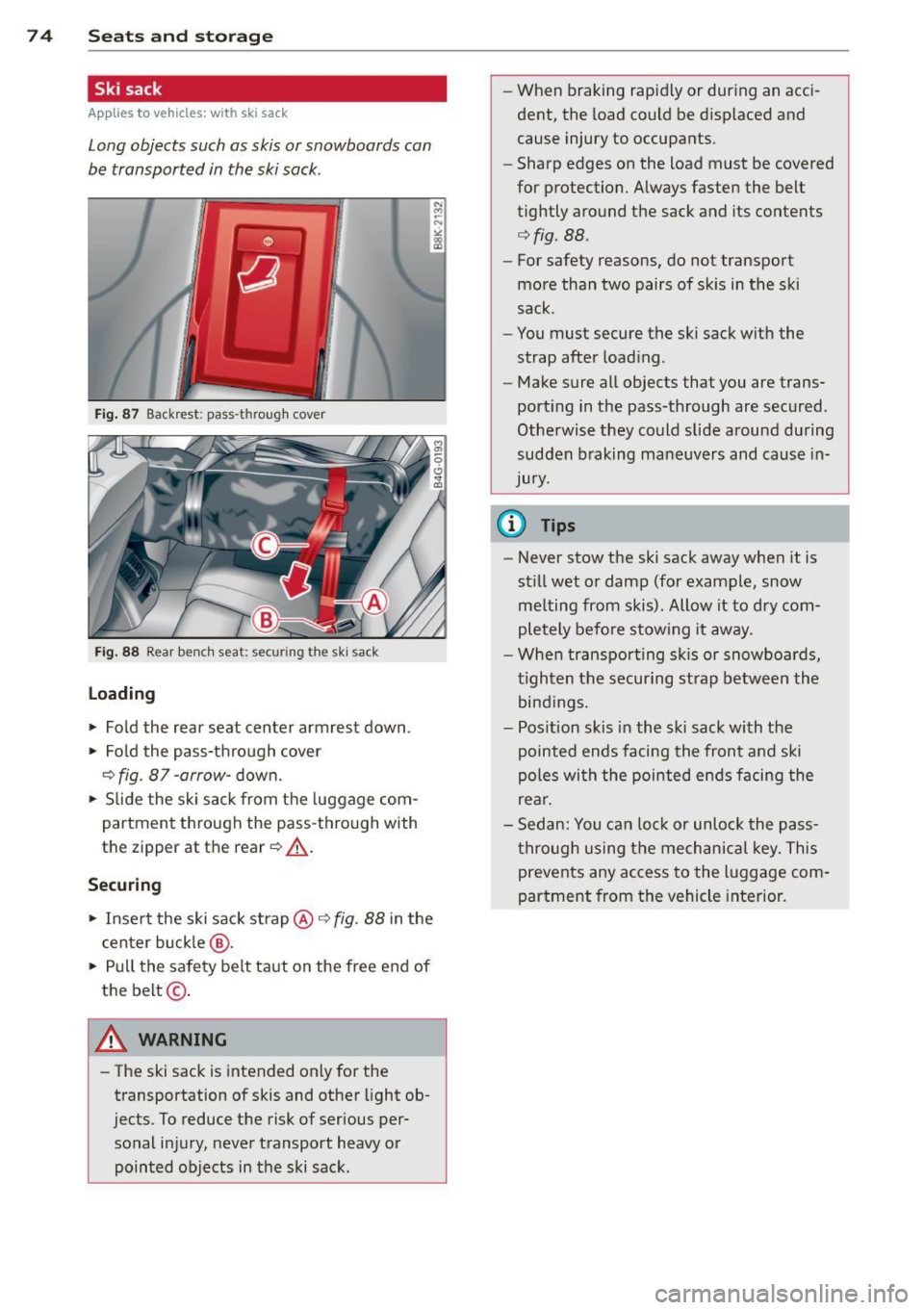
7 4 Seats and storage
Ski sack
App lies to vehicles: with sk i sack
Long objects such as skis or snowboards can
be transported in the ski sack .
Fig. 87 Backrest: pass -through cover
F ig . 88 Rear be nch seat: securing the sk i sack
Loading
.,. Fold the rear seat center armrest down .
.,. Fold the pass-thro ugh cover
¢fig. 87-arrow-down.
.,. Slide the sk i sack from t he luggage com
partment through the pass -through with
the zipper at the rear¢,&. .
Securing
.,. Inse rt the ski sack st rap @ ¢ fig. 88 in the
c en ter buck le @ .
.,. Pu ll the safe ty belt taut on the free end of
the belt @.
A WARNING
-The ski sack is intended only for the
transportation of skis and other light ob
jects. To reduce the risk of serious per
sonal i njury, never transport heavy or
pointed objects in the ski sack. -
When braking rapid ly or during an acci
dent, the load could be displaced and
cause injury to occupants.
- Sharp edges on the load must be covered
for protection. A lways fasten the belt
tightly around the sack and its contents
¢fig. 88.
-For safety reasons, do not transport
more tha n two pairs of skis in t he ski
sack.
- You must secure the ski sack with the
strap after load ing.
- Make sure all objects that you are trans
port ing in the pass-through are secured.
Othe rwise they could slide around du ring
sudden b rak ing ma ne uvers and cause in
Jury.
(D Tips
- Never stow the ski sack away when it is
st ill wet o r damp (for example, snow
me lting from skis). Allow it to dry com
pletely be fore stow ing it away.
- When transporting sk is or snowboa rds,
tighten the securing st rap between the
bindings .
- Pos ition skis in the sk i sack with the
pointed ends facing the front and ski
poles with the pointed ends facing the
re ar.
- Sedan: Y ou can lo ck or unloc k the pass
t hrough using the mechan ica l key. This
prevents any access to the l uggage com
partment from the vehicle interior .